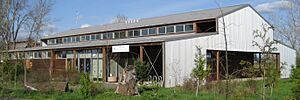Jackson Bottom Wetlands Preserve facts for kids
Quick facts for kids Jackson Bottom Wetlands Preserve |
|
|---|---|
|
IUCN Category IV (Habitat/Species Management Area)
|
|
| Location | Hillsboro, Oregon, USA |
| Area | 635 acres (257 ha) |
| Visitors | 25,000 (in 2005) |
| Governing body | City of Hillsboro |
| Website | hillsboro-oregon.gov |
The Jackson Bottom Wetlands Preserve is a special natural area in Hillsboro, Oregon, United States. It covers 635 acres of wetlands along the Tualatin River. This preserve is a designated Important Bird Area. Many birds live or visit here. You can spot buffleheads, dusky Canada geese, and even tundra swans. It is a wonderful place to explore nature.
Contents
History of Jackson Bottom Wetlands
The Atfalati people were the first inhabitants of this area. They were a band of the Kalapuya people. They hunted waterfowl and gathered camas roots.
From Farms to Wetlands
European pioneers settled here starting in the 1830s. They built farms, but the wetlands often flooded. So, this specific area was not used much. Bridges were built across the river. Steamboats also traveled the river before railroads arrived.
In 1910, the city of Hillsboro began using the Jackson Bottom area. By the 1930s, farmers protested the pollution. In 1939, the city bought part of the land. They used it as a "sewer farm" to grow produce. The city even made some money from this.
By the 1970s, the city owned most of the land. They stopped using it as a farm. The area then became a grassland. In 1980, a plan was made. This plan transformed the area into the wetlands preserve we see today. In 1999, the wetlands won an award. It was for education and outreach. Sometimes, trails were closed due to cougar sightings.
Exploring Jackson Bottom's Features
This preserve has many different types of habitats. You can find forest areas along the river. There are also forested wetlands, ponds, marshes, and meadows. Slough areas and mixed forests are also part of the preserve.
Animals of the Wetlands
Jackson Bottom is home to many different animals. You might see beavers, minks, and nutria. Ducks, blue herons, and green herons live here. Warblers, frogs, and owls are also common. Look for red-tailed hawks, woodpeckers, and opossums. Deer, raccoons, and newts also call this place home. Sparrows, finches, and coyotes live here too. Many small rodents, birds, and reptiles thrive in the wetlands.
Migratory Birds and Plants
Many waterfowl visit Jackson Bottom during migration. These include northern pintails and canvasbacks. Blue-winged teal and green-winged teal are also seen. Dusky Canada geese and tundra swans are regular visitors.
The plant life is also very diverse. You can find dogwood trees and Douglas fir. White oak, cocklebur, and Columbia River sedge grow here. Red willow and Oregon ash are common. Many other grass and tree species also fill the preserve.
Activities for Visitors
Jackson Bottom offers many things for people to do. There are hiking trails to explore. An education center helps visitors learn more. Environmental monitoring and research happen here. It is also a fantastic place for birdwatching.
Wetlands Nature Center
The Wetlands Education Center opened on September 27, 2003. This building is 12,000 square feet. It helps educate visitors about the wetlands. It has a large 3,000 square foot deck that wraps around it. Inside, you will find a classroom, a nature store, and exhibits.
The Bald Eagle Nest Exhibit
In January 2007, the Nature Center received a new exhibit. It is an intact bald eagle nest. This nest is 7 by 11 feet and weighs 1,500 pounds. It is believed to be the only intact eagle nest on display in the United States. An eagle family built the nest in 2001. It was along the Tualatin River. In 2005, the tree it was on started to fall. So, the nest was carefully removed. Inside the nest, you can see remains of the eagles' meals. These include fish and other birds.
The Nature Center also has a weather station. It was funded by a grant from Intel. You can see weather data online.
Education Programs
Jackson Bottom runs many education programs. They work with local schools. They also have summer camp programs. There is even a teacher education program. All these programs help people learn more about wetlands. They teach about water resources and protecting nature.



